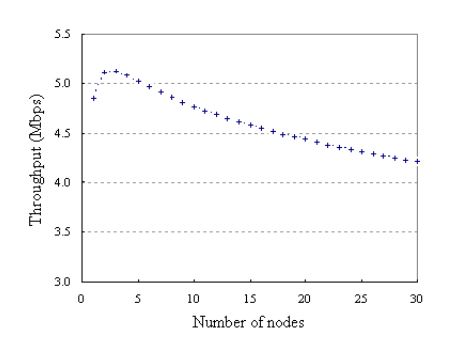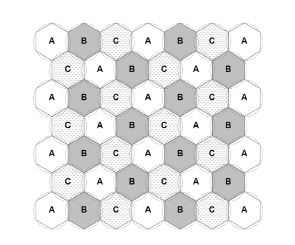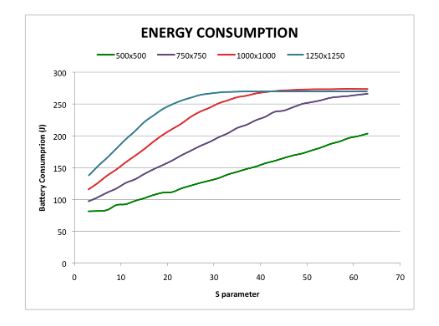ABSTRACT
In heterogeneous wireless sensor networks (HWSNs) such as HPWREN, the sensed data needs to be routed through multiple hops before reaching the main high-bandwidth data links. The routing is done by battery-powered nodes using license free radios such as 802.11. In this context, minimizing energy consumption is critical to maintaining operational data links. This thesis presents a novel routing mechanism for HWSNs that achieves large energy savings while delivering data efficiently.
This mechanism sits on top of the unmodified MAC layer so that legacy network devices can be used, and expensive hardware/software modifications are avoided. Thus, our approach is inexpensive and easily deployable. Our solution includes scheduling and routing algorithms. The TDMA-based distributed scheduling algorithm limits the number of active nodes and allows a large portion of nodes to sleep thus saving energy. Simulations and measurements on a testbed network show that scheduling can achieve as much as 85% power savings and up to 10% increase in throughput.
Scheduling is combined with the creation of a backbone of nodes that provides connectivity and delivers data to the proper destinations. The nodes of the backbone stay awake continuously for a predefined amount of time. Since it is an energy expensive task, they are dynamically selected so that those nodes that have more energy are more likely to become part of the backbone. Simulation results show that the combined scheduling and forwarding backbone approach achieves up to 60% energy savings per battery operated node and also have better performance when compared to existing techniques.
RELATED WORK
Recent deployments of heterogeneous wireless sensor networks with applications sensitive to latency and/or throughput have raised interest in research activities focusing on QoS-aware and/or energy efficient techniques. Inherent unpredictability of the wireless channel and limitations in design of commonly used MAC protocols lead to difficulty in guaranteeing QoS. For example, IEEE 802.11 MAC uses a random backoff mechanism when collisions occur, thus reducing the overall throughput, increasing the power-consumption and the delay.
SCHEDULING ALGORITHM

Figure 3.1: Throughput drop as a function of the number of nodes transmitting at full MAC queues
We observe that as the number of wireless nodes transmitting data at the same time increases, the throughput falls. This is because in heavy traffic conditions, the chance of nodes to successfully transmit a packet decreases dramatically as nodes spend a lot of time waiting for the channel to become idle. Intuitively, from Figure 3.1 it is clear that we can get a higher throughput by limiting contention to only a few nodes at a time.

Figure 3.3: Hexagonal network topology used in the simulations for the scheduling algorithm
Simulation parameters for 802.11b are set for the typical IEEE 802.11b wireless channel. The parameters for power in each power mode are from the data sheet of the Cisco Aironet wireless LAN adapter and the measurements presented. The size of the network is 533m by 550m and nodes are deployed with a hexagonal network topology as shown in Figure 3.3 that approximates the density of the HPWREN SMER subnetwork used to collect data traces.
FORWARDING BACKBONE

Figure 4.1: BcastSlot and BcastPeriod
A node volunteers to become a coordinator during the periodic BcastSlot (Figure 4.1) by sending an announcement message. The announcement message contains information about the sender and its neighbors. It includes the list of the node’s two-hop neighbors, specifying which ones are the coordinators and which ones are not (the status of a node). If two neighbors of a non-coordinator node cannot reach each other directly or via a maximum of two coordinator hops, then such a node is eligible to become a coordinator.
RESULTS

Figure 5.1: Average per node battery consumption (J) as a function of the S parameter
Another factor that affects the energy consumption (summarized in Figure 5.1) is the number of hops a data packet needs to traverse from source to destination. The more number of hops, the more the nodes are involved in receiving and transmitting data. These operations are power hungry (Table 5.1). Predictably, the larger the network area (and so the longer the distance from sources to destinations), the more hops are required.
CONCLUSION
We presented an energy efficient mechanism for scheduling and routing in heterogeneous wireless sensor networks such as HPWREN. This network offer the challenge of ensuring that node battery lifetime is long enough for data collection and delivery to happen in a timely manner while using COTS to ensure low cost and ease of deployment. The solution presented in this thesis includes a distributed scheduling algorithm that allows a large portion of nodes to switch off the NIC thus saving energy.
We prove its efficiency by deploying a testbed network, implementing the algorithm on nodes similar to those of HPWREN and taking measurements on them. Scheduling is then combined in a unique solution with the creation of a backbone of nodes in charge of delivering data to the proper destinations. Since being part of the backbone requires the node to stay awake continuously for a certain amount of time, the nodes of the backbone are dynamically selected so that those nodes that are more rich in energy are more likely to become part of the backbone.
By requiring no modifications to the MAC layer, our solution can be easily and quickly deployed on existing networks such as HPWREN where neither legacy devices need to be replaced nor firmware or drivers modified. Saving energy also lowers the cost of network maintenance by avoiding frequent and expensive replacement of batteries.
Source: University of California
Author: Edoardo Regini
>> More Wireless Sensor Networks Projects Abstract for Engineering Students
>> More Wireless Energy Projects for Engineering Students